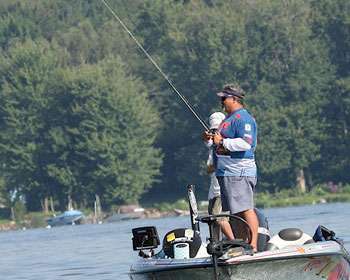
In an age when running and gunning often seems to be the only way to win at the highest levels of tournament competition, Florida pro Peter Thliveros is something of an anachronism. Given a choice, he likes to pick an area, get settled in it and grind out a winning catch.
"It doesn't mean that I don't fish fast sometimes," he says. "But if I can find the right grade of fish to do well, instead of just catching one or two and moving on, I'll sit there and try to catch the rest." So while many of his competitors don't feel they've done their job unless they've fished numerous spots in a single day, Thliveros said he's perfectly happy to focus on five or fewer — "and that's a lot for me," he adds.
Part of this tendency is derived from his Florida upbringing. First, Florida-strain largemouth are more likely to react adversely to cold fronts and other changes and therefore require a taunting, deliberate presentation. Several other factors come into play as well.
"These fish are heavily pressured," he says. "People fish for them 365 days out of the year. And Florida has always been known as a plastic worm fishery because of all the vegetation and the areas we are forced to fish." So what exactly constitutes fishing "slow"? Is it a set amount of time per cast? A particular amount of time in a given area?
For Thliveros, it's a matter of intuition. "I never give myself a set time," he explains. "I just feel like I try to make the most of what I have. If I go a certain period of time without any bites, I'll adjust my angle, maybe fish the other side of a grassbed. I don't keep on making the exact same cast." What about deadsticking a plastic bait or stitching it back to the boat with painful pauses?
Thliveros again says it's a matter of letting the fish tell you what they want. "They're in control 99 percent of the time," he says. "They'll give you the answers. If they're superaggressive, they'll hit it before it gets to the bottom. If you have to move it 20, 30 or 40 feet before you get a strike, they're not as concentrated. When you're fishing slowly, you're actually searching as much as you are fishing."
That's another reason that, while most of his peers on the Elite Series trail have taken to speed fishing, Thliveros has been able to stay competitive in a lower gear. While others fling crankbaits and spinnerbaits and retrieve them at often-blistering paces, his bottom-hugging slower presentations in what appears to be open water allow him to find cover that others can't see.
Typically, slow fishing involves a discrete set of lures: a Carolina rig, a football jig or a heavy Texas rig, but Thliveros expands the term to include just about every lure in his boat. "Slow is a relative term," he says. "You can fish a crankbait or a topwater slow and be successful. In fact, the standard old-time Florida topwater retrieve, especially with a bait like a Rapala, is to twitch it, let it sit until the rings disappear, and then twitch it again." Ultimately, he concludes, "it's all about efficiency — people often overlook the fact that you can be slow and efficient, too. You know when you catch a few fish there are often way more than what you catch on the initial pass. The goal is to milk it to the fullest potential."





